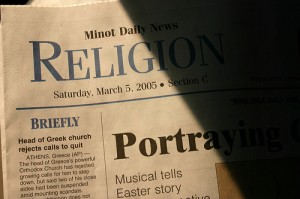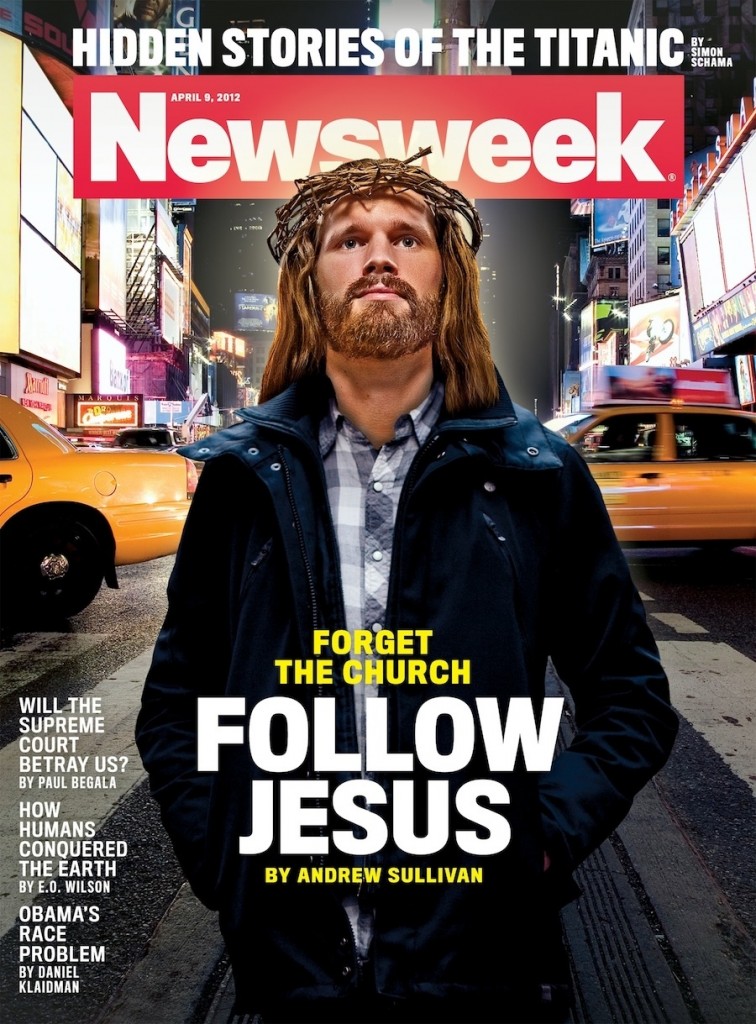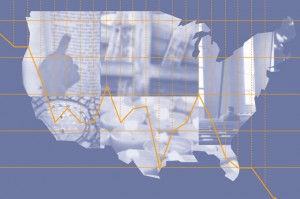America Is Becoming Less Christian, Less Religious
America is still a predominantly Christian nation, but it’s becoming both less Christian and less religious, according to the results of the new American Religious Identification Survey. According to the poll, which came out today, the percentage of Americans who define themselves as Christian has dropped from 86 percent in 1990 to 76 percent in 2008. In one of the most dramatic shifts, 15 percent of Americans now say they have no religion — a figure that’s almost doubled in 18 years. Americans with no religious preference are now larger than all other major religious groups except Catholics and Baptists.
“What seems to be happening is there is a decline in what we might call traditional brand loyalty to the old denominations, specific churches,” said Barry Kosmin, a principle investigator for the American Religious Identification Survey. In the last 18 years, despite population growth and immigration, almost all religious denominations have lost ground. Mainline Protestants are down the most. Methodists, for example, have gone from 8 to 5 percent. Baptists are down from 19.3 to 15.8. And Jews are down from 1.8 to 1.2 percent.
Meanwhile, the number of atheists, while still small, has nearly doubled from 900,000 to 1.6 million. Kosmin says that people may feel more comfortable admitting their lack of faith at a time when atheist books, like Christopher Hitchens’ “God Is Not Great: How Religion Poisons Everything” and movies are getting a lot of attention. Comedian Bill Maher took aim at religion in his documentary film “Religulous,” saying that he preaches “the gospel of ‘I Don’t Know.'”
But researchers point out that just because people are dropping out of organized religion, that doesn’t mean they’re abandoning faith. In an informal poll on Twitter today, we heard similar sentiments.
“I no longer attend church, but still pray to Jesus,” said Sean Whitney.
Dramatic Shift in Way Americans Worship
“I dropped out of the Catholic faith years ago. However, it doesn’t mean I have stopped believing in God,” said Carmen Rivera.
The study finds that more people are exploring spiritual frontiers. Some 2.8 million Americans now say they identify with new religious movements like Wicca, paganism or spiritualists. Catholic strongholds in New England and the Midwest have faded as people have moved toward the Sunbelt.
“We are becoming a nation of spiritually anchored people who are not traditionally religious,” said Serene Jones, president of the Union Theological Seminary in the City of New York.
While Americans may be leaving established denominations, the one major growth area in American Christianity is among evangelicals. Megachurches are booming, rising from 5 to 11.8 percent of the population.
And with the economy in free fall, many megachurches say they’re seeing increased attendance. They’re praying that perhaps hard times will draw Americans back to their faith.
The Religious and Social Crises and Political Consequences
The opening long decade of the 21st century (2000-2012) has been a period of repeated and profound economic and social crises, of serial and prolonged wars and declining living standards for the vast majority of Americans. How have people responded to this crisis? No large scale, long term, socio-political movements have emerged to challenge the bi-partisan dominent classes. For a brief moment the “Occupy Wall Street” movement provided a platform to denounce the 1% super-rich but then faded into memory.
Questions arose whether in the midst of prolonged hardship people would turn to religion for solace, escape into spiritual pietism. The question this essay addresses is whether religion has become the ‘opium of the people’ as Karl Marx suggested or whether religious beliefs and institutions are themselves in crisis, losing their spiritual attraction in the face of their inability to resolve the everyday material needs of a growing army of impoverished, low paid, unemployed and contingent workers and a downwardly mobile middle class. In other words are major religions growing and prospering in our time of permanent economic crise and perpetual wars or are they on the downslope part and parcel of the decline of the US Empire?
According to the latest data as of 2008 the biggest religious group is Christianity with 173.402 million members representing 76% of adult population followed by Judaism with 2.680 million representing 1.2% of the adult population; followed by Eastern religions 1.961 million and representing .9% Muslims 1.349 million representing .6% of adults. The second most populous group after the Christians are those adults who state they have ‘no religion’ 34.169 million or 15%.
Adult Population and Religious Affiliation 1990-2008 (in millions and percentages)
| 1990 Adults |
2008 Adults |
Numerical Change |
1990 % of Adults |
2008 % of Adults | Change in % of Total Adults 1990-2008 |
|
| Adult Population | 175,440 | 228,182 | 30.1% | |||
| (All) Christian | 151,225 | 173,402 | 14.7% | 86.2% | 76% | -10.2% |
| (All) Jewish | 3,137 | 2,680 | -14.6% | 1.8% | 1.2% | -.6% |
| (All) Eastern | 687 | 1,961 | 185.4% | .4% | .9% | .5% |
| (All) Muslim | 527 | 1,349 | 156% | .3% | .6% | .3% |
| No Religion | 14,331 | 34,169 | 138.l4% | 8.2% | 15% | 6.8% |
The dynamic trends over time show a declining percentage of adults who are Christians: between 1990-2008 they dropped from 86.2% to 76%; Jews have declined from 1.8% of adult population in 1990 to 1.2% in 2008 and Eastern religion is growing from .4% of adult population to .97% of population. Likewise, the percentage of Muslims in the adult population has grown from .3% in 1990 to .6% in 2008. The percentage of non-religious adult population has increased from 8.2% in 1990 to 15% in 2008.
While both practioners of Christianity and Judaism, as a percentage of the adult population, have declined, there is a sharp divergence in terms of numerical change; between 1990 and 2008 the number of Christians has increased by 2,218 million while the number of Jews has declined by 457 thousand. Judaism is the only one of the major and minor religions to decline in absolute numbers.
The combined number of Eastern and Muslim religious affiliates now exceeds Judaism by 630,000 believers about 30%. Jews today represent only 1.2% of the adult US population compared to 1.5% for Muslims, Buddhists and Hindus. The gap between Christians and non-religious US adults has narrowed over the past 20 years: from 86.2% to 8.2% in 1990 to 76% to 15% in 2008. Among Christians the biggest decline is among ‘mainline protestant churches’ (Methodists, Lutheran, Presbyterian, Episcopalian/ Anglican and United Church of Christ) from 32.8 million in 1998 to 29.4 million in 2008; and among “unspecified Protestants” from 17 million to 5.2 million. The biggest increases are among “non-denominational Christians” rising from 194,000 to 8.03 million believers in 1990-2008, unspecified Christians from 8.1 million to16.4 million and Pentecostals up from 5.7 million in 1990 to 7.9 million in 2008. Catholic and Baptists grew in numbers but barely held their own as a percentage of the adult population.
Analysis of Religious Trends in Political-Economic Context
Contrary to most observers and pundits, the economic crisis has not led to an upsurge in religious memberships or identification – the search for ‘spiritual consolation’ in a time of economic despair. The mainline churches and synagogues do not attract or even keep membership because they have little to offer in material solutions to their members in time of need (mortgage foreclosure, bankruptcies, unemployment, losses of savings, pensions or stocks). Contrary to some pundits even the more otherworldly, apocalyptic, Pentecostal, Charismatic, Born Again Churches while increasing their number have failed to attract a larger percentage of the adult population over the past 20 years; in 1990 they had 3.5% of adults and in 2008 4.4% an increase of .9%.
The crises decade has had several major impacts – it severely weakened religious identity with any specific denomination, it increased religious uncertainty and vastly increased the number and percentage of adult Americans who are no longer religious. Between 1998 and 2008, the percentage of adults in both categories doubled from 10.5% to 20.2%; the numbers increased from 18.34 million to 46 million. It would appear that most of the ‘non-religious’ are drawn from former mainline Christians and Jews.
The rise of non-religious adults between 1990-2008 cannot be related to greater education, urbanization and exposure to rationalist thought which has more or less remained the same over the two decades. What has changed is the rising discontent over declining income among wage and salaried workers, the vast increases in inequality, the perpetual wars and the public discredit of the principle political and economic institutions – Congress is viewed as negatively by 78% of Americans, as are banks, especially Wall Street. The religious institutions and religious faith is increasingly seen as irrelevant at best and complicit in the decay of American living standards and workplace standards. Despite the dramatic increase in ‘non-religious’ Americans close to 75% still claim to be believers of one or another version of Christianity.
The crisis in Judaism is far more severe than even the ‘mainline Christian’ churches. Over the past 20 years the number of adult Jews has declined by about 15%, over 450,000 former Jews ceased to identify as such. Some of the political economic causes for the flight from Judaism may be similar to the Christians. Others may be more specific to Jews: over 50% of Jews marry outside of the synagogue with non-Jews, cause and consequence of ‘defection’. Others may convert to other religions – Oriental or Christian. Some Jewish neo-conservative rabbis and ideologies rant about the threat of ‘assimilation’ being the equivalent of ‘genocide’. Most likely most former Jews have become ‘non-religious’ or secular and some of the reasons may vary. For some, Old Testament bloody tales and Talmudic rulings do not resonate with modern rational thought. Political considerations may also contribute to the sharp decline in self-identifying Jews: the ever tighter links and identity of Israel with Jewish religious institutions, the Israeli flag waiving and unconditional support of Israeli war crimes has repelled many former parishioners, who quietly retire rather than engage in a personally costly spiritual struggle against the formidable pro-Israel apparatus embedded in the inter-locking religious-Zionist networks.
Conclusion
The religious crises, the decline in belief and institutional affiliation, is intimately related to the moral decay in US public institutions and the precipitous decline of living standards. Among Christians the decline is incremental but steady;among Jews it is deeper and more rapid. No ‘alternative religious’ revival is in the horizon. The more fundamentalist Christian groups have responded by becoming more politically involved in extremist movements like the Tea Party demonizing public spending to ameliorate social inequities or have joined Islamophobic pro Israeli movements – precisely as increasing number of ex-Jews depart!
The secular or non-religious adult population has yet to organize and articulate a program in contrast to the fundamentalists, perhaps because they are too disparate a social category – in terms of socio-economic and class interests. ‘Not religious’ tells us little about what is the alternative. The shrinking percentage of religious believers can have several outcomes: in some cases it can lead to a hardening of doctrine and organizational structures ‘to keep the faithful in line’. In others it has led to increasing politicization, mostly on the extreme right. Among Christians it means insisting on literal readings of the Bible and anti- evolutionism; among Jews, the shrinking numbers are intensifying tribal loyalties and more aggressive fundraising, lobbying, and unconditional support for a “Jewish State”, purged of Palestinians, and more punitive witch-hunts against critics of Israel and Zionism.
What needs to be done is a movement that links the growing mass of rational non-religious people with the vast majority of American wage and salaried workers, experiencing declining living standards and the rising costs (material and spiritual) of imperial wars. Some religious individuals and even denominations will be attracted to such a movement others will attack it for sectarian and political reasons. But as a non-religious morality links individual and political crises to social action, so can the political community create the bases for a new society built on secular needs and public ethics.
New Russia Law on Religious Missions Explained
New Socialist Attack on Religious Freedom in Bulgaria
 Over 26 years after the fall of the communist regime, the socialists left are reintroducing a new war against Christianity and religious freedom in Bulgaria. Two weeks after the introduction of draconian bill by George Kadiev, imposing full state control over believers and churches, the socialist parliamentary group filed in the registry of the National Assembly on March 14th a broader bill to restrict religious liberty in Bulgaria via government regulations according to which unregistered religions (faith confessions) have no right to:
Over 26 years after the fall of the communist regime, the socialists left are reintroducing a new war against Christianity and religious freedom in Bulgaria. Two weeks after the introduction of draconian bill by George Kadiev, imposing full state control over believers and churches, the socialist parliamentary group filed in the registry of the National Assembly on March 14th a broader bill to restrict religious liberty in Bulgaria via government regulations according to which unregistered religions (faith confessions) have no right to:
- Hold religious meetings;
- Create and maintain charitable or humanitarian institutions;
- Write, issue and disseminate religious publications;
- Have educational establishments;
- Collect and receive unsanctioned donations;
- Associate or confide with people and communities at home or abroad on subjects of religion and religious issues.
In practice, the new bill introduces a new form of compulsory registration of believers by the state. The left socialist legislators seek to repeal fundamental human rights enshrined in Bulgaria’s Constitution and the European Convention for the Protection of Human Rights and Fundamental Freedoms (ECHR), as follows:
- The right to freedom of thought (Art. 9 ECHR and Art. 37 CRB)
- The right of forming beliefs and the non-obligation to give information about one’s convictions (Art. 38 CRB, Art. 9 ECHR)
- The right to freedom of conscience and religion (Art. 9 ECHR Art. 37 CRB)
- Freedom of speech, press and media (Art. 40 CRB)
- Right of expression (art. 10 ECHR, Art. 39 CRB)
- Freedom to collect and disseminate information (Art. 41 of the CRB; Art. 10 ECHR)
- Freedom of assembly indoors without permission from the authorities (Art. 43 of the CRB, Art. 11 ECHR)
- The right to freedom and confidentiality of correspondence (Art. 34 CRB; cf. Art. 8 ECHR)
- Revocation of the right to freedom of association (art. 11 ECHR Art. 44 CRB).
In the unfortunate event that this bill passes under the law, it will impose, the already prohibited by the Constitution, obligatory state ideology. It will also violate separation between church and state, according to which the state cannot interfere in the internal life of churches and religious communities. Furthermore, in attempt to limit the freedom of the people, it will impose expressed governance and control of faith, beliefs and personal conviction; thus, endangering fundamental human rights and freedoms inherent to democracy.
Increase of Religious Non-Identifiers in America
 There is a documented and marked decline since 1990 in the number of Americans espousing a religious identity, from less than one-tenth of the public to nearly one in every six adults today. Far from being randomly distributed in the population, the data portray non-identifiers as more likely than those expressing a religious affiliation to be young, male, living in the West and New England, moderate-to-liberal politically, and unmarried.
There is a documented and marked decline since 1990 in the number of Americans espousing a religious identity, from less than one-tenth of the public to nearly one in every six adults today. Far from being randomly distributed in the population, the data portray non-identifiers as more likely than those expressing a religious affiliation to be young, male, living in the West and New England, moderate-to-liberal politically, and unmarried.
A lingering question for this research is whether the decline in psychological affiliation with any church or denominational organization will persist, level off, or reverse course. Will the decline in religious identification observed in this research continue or prove to be a temporary phenomenon?
If the question is meant to refer to the traditional, established churches and faith systems that have been with us for some time, the answer is very likely to be yes, it is likely to continue. But if we expand the concept of “religion” to include the increasingly popular forms such as New Age religions, EasternWestern blends, multi-stranded hybrids, the “small-group movement,” pseudo-scientific spiritual formulations, and other types, then maybe no.
This study is an excerpt from the larger report on The Decline of Religious Identity in the United States by Sid Groeneman & Gary Tobin published in 2004 via the Institute for Jewish & Community Research (http://jewishresearch.or)
Religious Characteristics of Non-Identifiers
 26% No past religion, no current attendance, no religion in future
26% No past religion, no current attendance, no religion in future
19% Past religion, no current attendance, no religion in future
11% Past religion, no current attendance, possible religion in future
11% Past religion, current attender, possible religion in future
10% Past religion, current attender, no religion in future
9% No past religion, current attender, no religion in future
8% No past religion, no current attendance, possible future religion
6% No past religion, current attendance, possible religion in future
This study is an excerpt from the larger report on The Decline of Religious Identity in the United States by Sid Groeneman & Gary Tobin published in 2004 via the Institute for Jewish & Community Research (http://jewishresearch.or)
Heritage and Religious Identification
Fully 16% of the HARI sample answered either “none” when asked how they identify themselves or gave one of the other answers classified equivalently (atheist, agnostic, secular, Humanist, or Ethical Culture).
The largest number of non-identifiers (35%) were not raised in any religion as a child. Nevertheless, 62% of them had religious training or background. This compares with virtually all (97%) of respondents designating a current religion. The fact that well over half of current non-identifiers were raised in some religion indicates substantial attrition in the proclivity to claim a religious affiliation. Movement in the opposite direction — from no religion to a current identification — is less extensive (26% of those raised in no religion now identify with some religious category). This opposite-direction movement — acquiring a religious identity after having none in childhood — is not nearly large enough to off set the elimination of identity among those with a religious upbringing. Among adults alive today, our calculation produces a net loss of about 8% in the number having a religious identity relative to when they were young.
The fact that well over half of current non-identifiers were raised in some religion indicates substantial attrition in the proclivity to claim a religious affiliation. Movement in the opposite direction — from no religion to a current identification — is less extensive (26% of those raised in no religion now identify with some religious category). This opposite-direction movement — acquiring a religious identity after having none in childhood — is not nearly large enough to off set the elimination of identity among those with a religious upbringing. Among adults alive today, our calculation produces a net loss of about 8% in the number having a religious identity relative to when they were young.
This study is an excerpt from the larger report on The Decline of Religious Identity in the United States by Sid Groeneman & Gary Tobin published in 2004 via the Institute for Jewish & Community Research (http://jewishresearch.or)
Religious Praxis without Religious Identity
 Some people who do not identify with a religion, nevertheless, practice some form of religion
Some people who do not identify with a religion, nevertheless, practice some form of religion
Sizable numbers of those who do not affiliate psychologically with any religion are, nevertheless, occasional or unsettled practitioners. As such, they might sometimes attend religious services, have previously identified religiously as adults, or expect to take up a religion sometime in the future. A more complete religious profiling requires additional information about religious beliefs and behavior.
Gallup Polls, which use a differently worded question emphasizing “religious preference,” seem to indicate less change over the same time period as well as a lower current proportion of “no religion” / “none” responses. Unfortunately, Gallup changed the question wording several times, complicating analysis. Since mid-2000, they included the “if any” phrasing in their primary version of the question: “What, if any, is your religious preference — Protestant, Roman Catholic, Jewish, Mormon, Muslim, or an Orthodox religion such as Greek or Russian Orthodox?”
This study is an excerpt from the larger report on The Decline of Religious Identity in the United States by Sid Groeneman & Gary Tobin published in 2004 via the Institute for Jewish & Community Research (http://jewishresearch.or)
Religious Change in Contemporary America
 Compared to even 15 years ago, fewer Americans today espouse a religious identity. In this report we examine not religious practice like church attendance or membership but rather religious identity.
Compared to even 15 years ago, fewer Americans today espouse a religious identity. In this report we examine not religious practice like church attendance or membership but rather religious identity.
Approximately one of every six Americans has no religious identity
Sixteen percent of United States adults either fail to place themselves in any denominational category (answering “none” or ”no religion”), or they describe themselves as secular, humanist, ethical-culturalist, agnostic, or atheist.
Individuals who identify with no religion are a growing population
Based on a review of survey evidence, the proportion of non-identifiers appears to have grown substantially in the last 10-12 years.
The non-religiously identified make up the third largest group in the country
The two largest groups are Catholics and Baptists. Those non-religiously identified are virtually tied with Baptists as the second largest group since the difference in estimated size between them is within “sampling error.”
Those raised in no religion are most likely to not identify with a religion
About 1 of every 9 Americans who was raised in some religion now identify with no religion; nearly three-quarters of those with no religious upbringing are current non-identifiers.
Being raised in more than one religion may lead to no religion
Those raised in multiple religious traditions are more than twice as likely to be non-identifiers as adults than those raised in a single religion.
Younger Americans are less religiously identified than older Americans
Younger adults (under 35) are most likely to be non-identifiers, and those over 65 are least likely to be. Religious identification shows a steadily increasing association with age. It is unclear whether this represents a persistent growth trend in non-identifiers, or if it reflects a snapshot in time, with younger people likely to become more affiliated with religion as they pass through customary life-cycle stages. Non-identification in the United States likely will continue to increase
This study is an excerpt from the larger report on The Decline of Religious Identity in the United States by Sid Groeneman & Gary Tobin published in 2004 via the Institute for Jewish & Community Research (http://jewishresearch.or)
RELIGIOUS FREEDOM in BULGARIA 2011
Bulgarian nationalists attacked Jehovah’s Witness temple in the port city of Burgas on Palm Sunday, after an “organized protest” turned into a mass brawl in which five members of the faith confession were seriously injured. The Bulgarian Evangelical Alliance immediately issued a declaration against violence based on religious differences and the evangelical churches in the city held a press conference condemning the violent attack as an unacceptable form of protest in a democratic society. While the organizers are being investigated, we ask that you continue to pray for the situation, as we regularly minister in the city and the surrounding areas after watching the video recording below.









